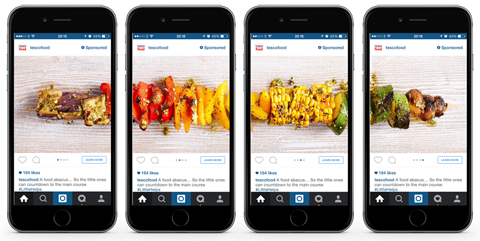
Building an Instagram advertising strategy is becoming the key to a successful social campaign, with the platform boasting over 400 million active users per month and an average of 80 million photos posted per day.
The platform’s current per-follower engagement rate is 4.21 percent. That said, it takes a bit more than publishing attractive photos to get a slice of the action. A well-branded visual identity needs the support of creative engagement tactics to achieve maximum conversions and drive sales.
This means developing a balanced strategy and employing the proper tactics. Keep reading and learn how to establish and tweak the best practices for your Instagram advertising strategy.
We’re about to explore how use a variety of image, video, and carousel campaigns to get results with sponsored ads. When this post is through you’ll know just what makes for a great Instagram post, how to organize and schedule posts, what to hashtag, and how to achieve the best conversions for all your efforts.
#1: Connect Your Instagram Account to Facebook
In order to start advertising on Instagram, you’ll need to connect your Instagram account to your Facebook page. This allows you to create your ads in Facebook Power Editor.
- First, head to your Facebook page and click “Settings” in the upper-right corner of the page.
- Click “Instagram Ads” then click “Add an Account” on the right side.
- If you have an Instagram account, click “Add an Existing Account,” your username and password.
- If you don’t have an Instagram yet, you can create one here in Facebook. Select “Create a New Account,” enter a username for the account and enter your email. Click confirm
(Source)
#2: Target the Right Audience
Targeting options on Instagram are similar to Facebook – including location, demographics, actions, interests, and more. Only location, age, and gender are required when defining your targets.
(Source)
Pro Engagement Tip: Brett Farmiloe, founder of Markitors, offers a clever way to build your Instagram following and maximize engagement: identify your customers already on Instagram.
“The first step is to export a list of all customer phone numbers and contact information from your database or CRM. Take that list and import them as contacts into your Gmail account. Then, import those phone numbers and contact info from Gmail into a smartphone and log into your Instagram account on your phone.”
From here, activate Instagram’s “Follow All Contacts” feature. This will find all your contacts already on Instagram and then allow you to select and follow them.
#3: Select Ad Types
How you advertise is reliant upon what type of engagement you’re looking to pick up with your ads. To be effective, many posts will be needed to target multiple audiences within a larger multi-touch campaign.
The potential of Instagram lies in creating and telling a compelling story about your brand. Engaging viewers with quickly captured moments and coordinated visual sequences will give your company a chance to interact with followers in a more casual and authentic fashion than other channels.
Three ad objectives are available on Instagram:
- Clicks to/conversions on your website
- Mobile app installs
- Video views (30 seconds)
Three ad units are available through Instagram:
- Image – square photos with a button driving users to click
- Video – the same as image ads but with video
- Carousel – a series of images users can swipe to browse
Image Ads
Pictures are a great (and easy) way to show off a new line of products, offers, a sweepstakes, or display new content. There are currently no limits to amount of text allowed in an Instagram photo, so you can tell a visual and textual story with one image.
Ecommerce apparel company Gilt makes great use of sponsored image ads:
(Source)
This image is super appealing, playing into the human love of symmetry and the great pairing of blues and browns. What’s more, this image style rides the wave of hype and engagement from #ThingsOrganizedNeatly, a trending design account. With an excellent aesthetic and a relevant style, no wonder the post is racking up likes and comments to drive downloads for the Gilt App.
(Source)
Sponsored Posts
Another way to tap into the power of influencers is to find large Instagram accounts already catering to your demographic and pay for sponsored posts on them.
Many Instagram accounts are being built solely for the purpose of selling featured shout-outs.
You can recognize these accounts (after you find and follow them) by the email address in the bio – and some tagline like “For Business Inquiries.”
Emailing these accounts to ask about proper fit and pricing is the next step.
Once you make a deal, look at some of the previous posts on the account to inform the type of content for ad images/video and copy.
Video Ads
Video is both highly engaging and actionable within the proper audience. Videos should quickly grab user attentions, as no one wants to sit through a boring video.
Instagram videos are perceived as authentic and organic. And now, Instagram offers the mini-video, a 15 second GIF option similar to Vine. Seen as being a more artsy and whimsical in its delivery, the shorter-form messaging is meant to delight. As a result, it’s great for building up positive brand image. It’s best to keep the tutorials and demos on Youtube, where informational content is expected. As with all content, videos should match with your brand aesthetic.
Teen clothing brand Topshop excels at creating videos that resonate with their young audience – and look just like those their audience would shoot themselves.

(Source)
The CTA and brand tagline at the end are the only suggestion that this isn’t user-generated content. As a means to generate community engagement and drive sales through referrals, many brands use user-generated videos to boost their popularity amongst followers.
Users trust each other: 74% of users rely upon social media to inform a purchasing decision. Taking word-of-mouth videos, branding them subtly, and placing a call to action on them can make a world of difference for a buyer on a journey with your product.
The key is to make the video about the audience rather than your business. Encourage fans to create their own videos (maybe with a sweepstakes entry, discount, free demo, or download) and collect these on your page. The more user-generated content a brand acquires, the more authentic credibility and trust they gain.
Carousel Ads
Carousel is the evolution of the visual storytelling element within Instagram. Using this format will allow you to create a stronger narrative in a rich cohesive way – and drive greater action as a result.
Here are the guidelines of using the sequential images of Carousel:
Grab their attention: The first rule of online storytelling is start out strong. The initial image in your carousel should grab attention and make sense on its own. Since some users may not swipe, share the message right away and avoid any confusion.
Get them swiping: When readers and users finish a story to the end, retention and expose increases. So having users complete the story is key. Tesco Foods uses great open-loop visuals to keep users swiping to the delicious end:
Set the scene: Using text to supplement the storyline will give users context, helping them feel like part of the picture.
Employ visual variety: Choose an assortment of images shot from different locations, angles, distances, etc. to increase interest. This Target ad-wheel paints a process-oriented image in the user’s mind, helping them connect to the jeans.
Leave the audience wanting more: Withholding a proper visual conclusion from users will entice them to click or pursue that ‘learn more’ conversion action you want.
#4: Use Relevant Hashtags
Instagram is filled with hashtags that are used by broad and targeted audiences, ie #ThrowbackThursday, #NoFilter. Using hashtags gives you an opportunity to inject your ads and brand culture in the feeds of those individuals using these hashtags.
With 30 hashtags allowed per post or comment, you can pick out branded hashtags to align content themes or tie your posts to larger trends.
While your Instagram advertising campaign will be largely organized, capitalizing upon and riding new trends is a powerful aspect of the platform.
Hashtags also allow users to discover new accounts to follow, so using hashtags to follow influencers and complementary brands within your field will be beneficial. Influencers are instrumental in helping your audience make buying decisions. Seeing what they post and following their lead will lead to success – and maybe an influencer collaboration.
Speaking of influencers, this ad from Spring reaches all the way to the top, using a Vogue quote to drive downloads:
(Source)
The Spring ecommerce app pulls big weight here with social proof from Vogue. Many marketers prefer not to use text in Instagram ads, going for a more organic feel, but this one nails it. With referral marketing on the rise and users more reliant upon the values and experiences of their fellows, expect these to stick.
#5: Use Calls to Action
All ad types allow for text within the image, but links cannot be active within pictures. So creating images and videos with hashtags and links will be important.
That said, active links must be placed within the Instagram bio of the brand. They cannot be placed within the comments section.
Check out how online retailer Frank & Oak places a call to action (CTA) for their product:
This ad does a great job of placing a CTA in the bio and then asking users in the comments to click the link.
Sharing an image with a CTA to download a ebook, white paper, or sign up for a newsletter is easily done here. Connecting the visual content to the idea that staying connected is important will increase your conversions. When users do take action you then have a chance to engage them on a one-to-one basis.
The most effective way to do this is create a separate, targeted landing page for your Instagram following. Messaging that references Instagram and keeps a consistent layout and design will make users most comfortable in this step down the funnel.
You’ll want your URL to fit nicely and neatly in your Instagram bio, so consider use a URL shortening service and creating a vanity URL. Bit.ly is a great choice.
Another advantage of these URL shorteners is their ability to track traffic when users visit your website from Instagram. Sadly, Google Analytics can’t accurately track this.
Checking the data will show you how many clicks your Instagram is sending to your site.
Rememeber to create a different bit.ly (or other) link each time you change the link for a new landing page, campaign, or default page.
#6: Review Performance
Metrics such as overall followers, quality of comments and likes received, branded hashtag mentions, and location tags can help you develop a sense of your publishing results and quality of engagement.
Many free analytics tools exist for Instagram. These can show you when is the best time to post, what hashtags receive the most engagement, who top followers are (for easier targeting), keyword analysis for comments, and what content is performing well.
Key Takeaways
When it comes to paid advertising on Instagram it’s important to use your options. Between images, video, and carousel formats, brands can engage and drive action with users with various storytelling methods and styles.
Companies that use hashtags, influencers, and user-generated content to further their ad reach will see results with added engagement and increased conversions. Setting up alternate landing pages for CTAs within posts is also highly recommended. At the end of the day, following these steps can help your brand get results from one of the best paid ad channels available.
Digital & Social Articles on Business 2 Community
(144)
Report Post
















